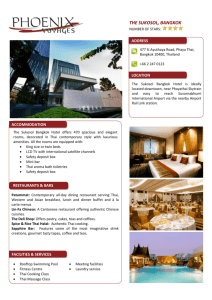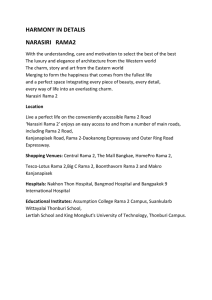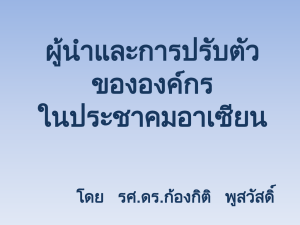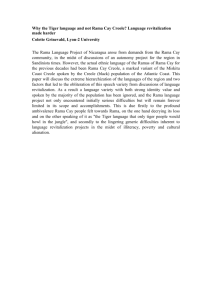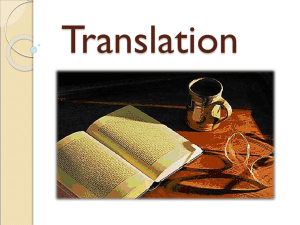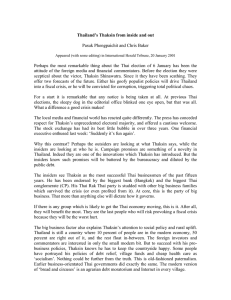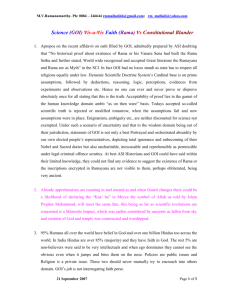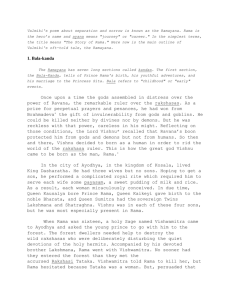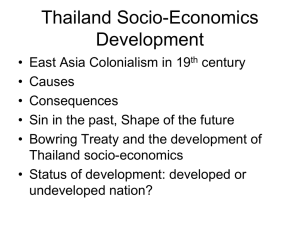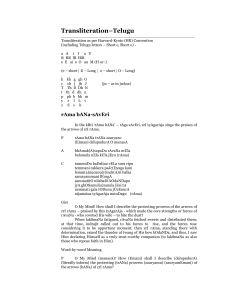Slide1
advertisement
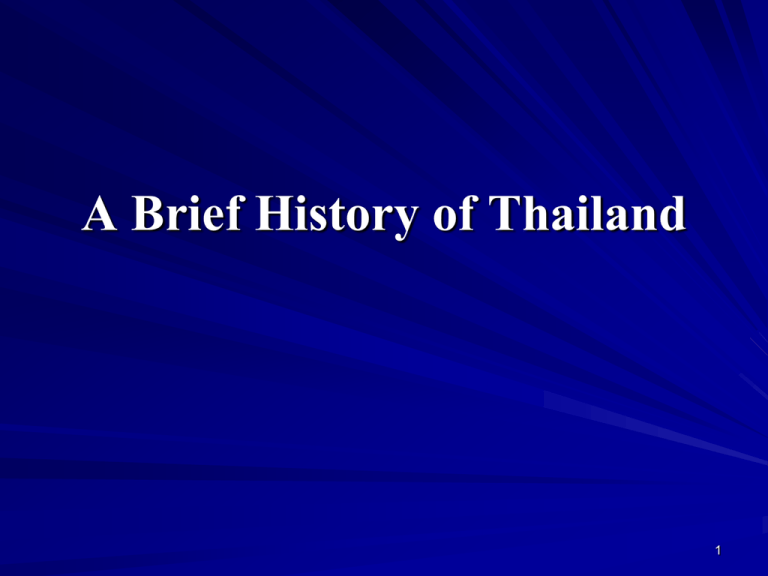
A Brief History of Thailand 1 • A quick look at almost 800 years of Thai History • Political background and environment for understanding economic changes • Interaction between Thai economy and other aspects of society + outside world 2 The first Thai kingdom was established in A.D.1238 at Sukhothai Reached its peak during the reign of King Ramkhamhaeng, who invented Thai alphabets 3 The kingdom of Ayutthaya existed for 400 years from 1350 to 1767 , absorbing Sukhothai in 1376 Siam as the strongest power in southeast Asia by the end of the fourteenth century 4 Thai kings: absolute monarchs, “the lord of the land” and “divine king”, at the apex of social and political hierarchy 5 The sakdi na system: The king allotted rice fields to officials in payment for their services. Manpower in command determined their status phrai (servants) at bottom of hierarchy 6 Peasants planted rice for their own consumption, taxes, and exported to China Foreign traders, including the Chinese, Indians, Japanese and Persians, and later the Portuguese, Spanish, Dutch, British and French 7 Siam fought constant wars for territories with neighbors: Chiangmai , Vietnam, Cambodia, and Loas 8 Burma defeated Ayutthaya twice. First in 1569, King Naresuan restored independence 9 Burma defeated Ayutthaya twice. Second in 1767, the city was ransacked. Thai military commander, later became King Taksin, in 1769 moved the capital to Thonburi, across the Chao Phraya River from Bangkok 10 Mentally ill Taksin was deposed by Chaophraya Chakree, King Rama I (1782 – 1809), first king of the present Chakree dynasty, chose Bangkok as capital 11 Power consolidation, and conflicts with Burma, Vietnem and Laos Since King Rama IV, or King Mongkut (1851 – 1868), dealt with colonial powers of Britain and France, modernized to avoid being colonized 12 The Bowring treaty with Britain, which • restricted import duties to 3 %, • abolished royal trade monopolies, and • extraterritoriality to British subjects. 13 King Rama V, or King Chulalongkorn (1868-1910) continued the reform: Centralized administration Slave abolition Railways, telegraph Gold standard Modern taxation 14 “Buffer state”, but land loss to Britain and France: Parts of Burma, Loas, Cambodia, and Malaya The land loss was the price paid for remaining free. 15 King Rama VI (1910-1925): • Modernized education • Promoted nationalism, paramilitary organization • Declared war on Germany in WW I 16 King Rama VII (1925-1935): • Economic problems and the Great Depression (1930) • Laid off officials to stabilize economy 17 King Rama VII (1925-1935): • A coup on June 24, 1932 by 49 “Promoters”, changing absolute to constitutional monarchy • Later abdicated to King Rama VIII 18 1932-1973: dominated by military dictatorship Prepared for democracy by reform in education, elections Thammasat University founded in by Preedee Phanomyong, one of the “Promoters” 19 General Phibunsongkram (Phibun) emerged as Prime Minister with “fascist” / “nationalistic” policies: • Political repression • Campaign against Chinese • “Siam” to “Thailand” 20 General Phibunsongkram (Phibun) emerged as Prime Minister: • Alliance with Japan in WW II • Ousted and came back after Preedee post-war government • Postwar economic boom 21 A coup against Phibun in 1957: • A new PM General Sarit Thanarat • Start economic planning 22 PM General Sarit Thanarat • A U.S. ally during Vietnam War • Modernization and Westernization of Thai society • Population boom 23 General Thanom Kittikachorn (+ General Prapas) continued military rule in 1963: • Economic progress and Bangkok growth • Rural poor and activist movement 24 General Thanom Kittikachorn (+ General Prapas) continued military rule in 1963: • Role of university students: critical of military, demand democracy 25 Student protest in October 1973, bloodshed in Thammasat (14 October) King Bhumibol’s intervention, ending the Thanom-Prapas junta 26 Post-1973 civilian rule was shortlived, and weakened by sharp oil price increase in 1974, leading to recession and inflation Communist regimes in Vietnam, Laos, and Cambodia 27 Violent between right-wing groups and radical students on October 6, 1976 Return of political purge drove students to join Communist Party; Puey Ungphakorn went into exile 28 Another "coup" and military PM General Kriangsak Chomanand, forced out by high oil prices in 1980 and succeeded by army commander-in-chief, General Prem Tinsulanonda 29 Eight years under Prem: • End military interventions, insurgency • Amnesty for ex-students • Fast economic progress in exports, tourism and industries: “little tiger” 30 Elected government of General Chaticahi Choonhavan Another coup against “corrupt regime”, led by Generals Sunthorn Kongsompong and Suchinda Kraprayoon in 1991 brought in a civilian prime minister, Anand Panyarachun 31 1992 election and Suchinda accepting to be PM led to huge protest by the Bangkok middle class and bloody clashes with soldiers, prompting the King’s intervention and Suchinda’s resignation 32 Elected governments since then: • Chuan Leekpai (1992-1995 and 1998 – 2000) • Banharn Silpa-acha (1996) • General Chavalit Yongchaiyudh (1996-1997) • Thaksin Shinawatra (2001-2006) 33 Chavalit government and the economic crisis in 1997 Thaksin and his popularity, CEO-style, • 73 billlion baht sale of Shin shares tax-free, and • Snap April 2006 election 34 35 A military coup on 19 September 2006 ousted Thaksin, and installed the Surayud Chulanont Government 36 Another constitution and another election (23 December 2007) gave the highest MP seats to the pro-Thaksin People Power Party 37 A six-party coalition government, headed by PM Samak Sundaravej, leader of the People Power Party Thaksin came back to face charges, but went into exile again in August 2008 38 Somchai Wongsawat briefly led the government, replacing Samak, who was disqualified due to his cooking class TV show 39 The Democrats managed to form a new coalition government, led by Abhisit Vejjajiva, who took office in December 2008 and had to deal with domestic political instability and the impact of the economic “hamburger” crisis 40 Questions to think about: a) b) What if Thailand was colonized (by either Britain or France)? Have political changes and uncertainties affected economic development in Thailand? 41

